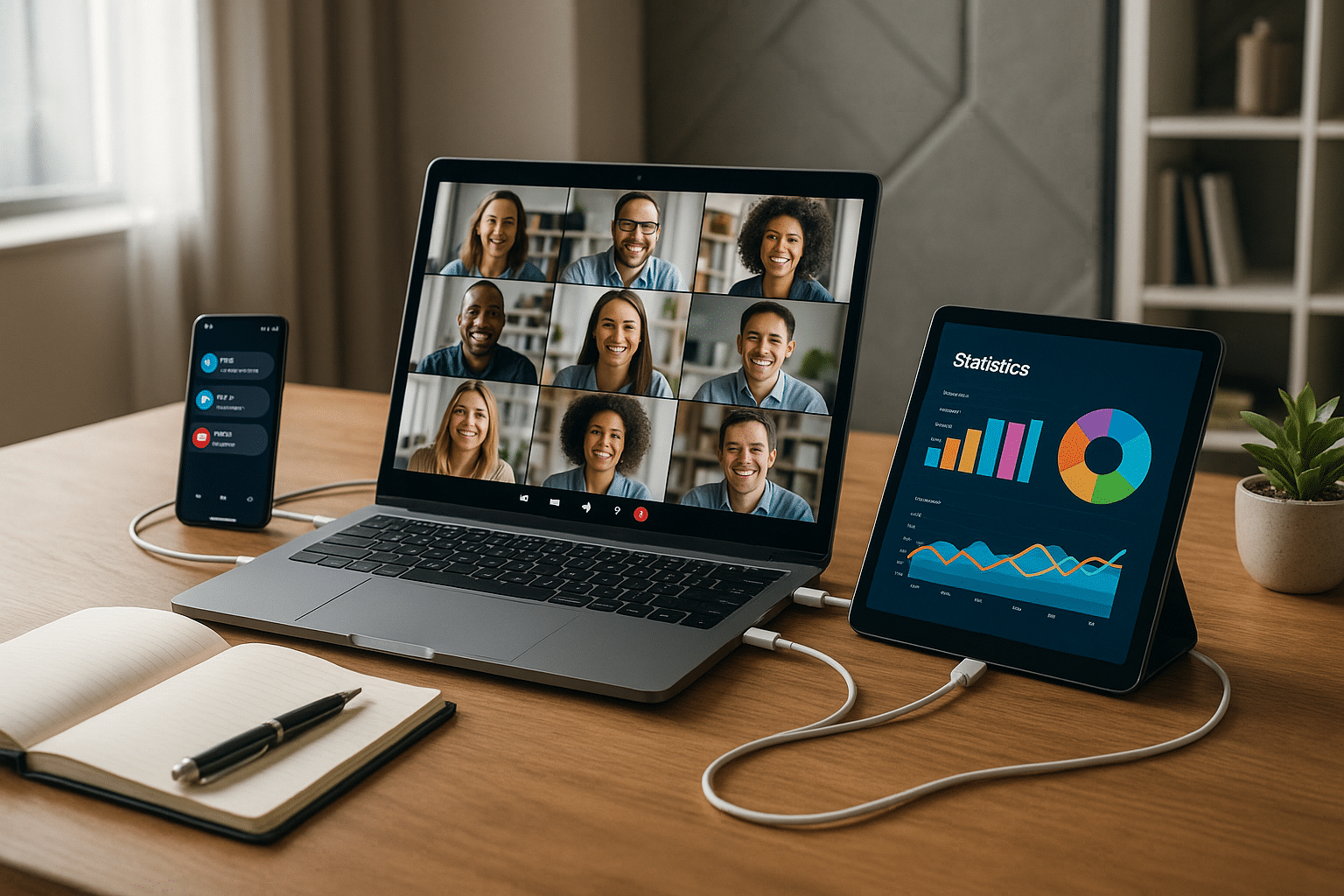In a world increasingly reliant on digital platforms, we’re no longer merely trying to capture eyeballs; we’re striving to establish deep, meaningful connections across multiple devices. Building these connections is no small feat. The journey from screen to screen is fraught with challenges, but also brimming with opportunities. To aid you on this journey, we’re going to delve into the art and science of achieving ‘Screen-to-Screen Success: Building Stronger Connections Across Devices for Maximum Engagement.’ 😊
Our digital landscape has evolved dramatically over the past decade. We’ve moved beyond the era of single-screen interactions to a multi-device, multi-screen world. For businesses and content creators, this shift presents a unique set of challenges and opportunities. How can we engage effectively with users who are constantly switching between smartphones, laptops, tablets, and smart TVs? And more importantly, how can we leverage this trend to build stronger, more enduring relationships with our audience? 🤔
In the following sections, we’ll dissect the concept of screen-to-screen engagement, exploring strategies to seamlessly transition your audience from one device to another without losing their interest or attention. We’ll delve into the role of responsive design, personalized content, and analytics in creating a smooth, engaging cross-device experience.
We’ll start by defining ‘Screen-to-Screen Success.’ We’ll explore the nuances of this concept and why it’s become such a vital focus in the digital world. We’ll discuss how achieving screen-to-screen success isn’t just about making your content available on multiple devices; it’s about crafting a cohesive, engaging narrative that follows your audience as they move from one screen to the next.
Next, we’ll look at the importance of responsive design in a multi-screen world. 📱💻🖥️ We’ll discuss how a ‘one-size-fits-all’ approach can be detrimental to user engagement, and why it’s essential to tailor your content and design to suit the unique characteristics of each device.
From there, we’ll dive into the role of personalized content in fostering stronger connections across devices. We’ll discuss how personalization can help create a seamless, engaging experience, regardless of the device your audience is using. And we’ll provide practical tips for implementing effective personalization strategies.
Finally, we’ll delve into the world of analytics and how data can guide your screen-to-screen strategy. We’ll discuss the importance of tracking user behavior across devices, and how this information can inform your content creation and distribution strategies for maximum engagement.
By the end of this article, you’ll have a firm grasp on the essentials of building stronger connections across devices, and the tools and strategies you need to achieve screen-to-screen success. Ready to dive in? Let’s get started. 😎
Understanding Screen-to-Screen Engagement: Why it’s a Game-Changer
In the digital age, businesses must learn how to create meaningful connections with their customers through various screen interfaces. This is called screen-to-screen engagement, and it’s a game-changer for how we interact and conduct business online. It’s not just about pushing out content, but about creating meaningful dialogues and building relationships across various devices.
Screen-to-screen engagement is crucial for businesses that want to maximize their reach and engagement in a digitally connected world. Successful businesses understand that their customers are using multiple devices, and they are strategizing to reach them effectively on each of these platforms. To truly understand the impact of screen-to-screen engagement, let’s dissect its key elements and how they impact customer engagement and business success.
At its core, screen-to-screen engagement is about building a seamless user experience across different devices. In other words, it’s ensuring that your content and interactions are consistent, responsive, and user-friendly whether your customer is using a desktop, smartphone, or tablet. It’s about recognizing that each screen is a unique touchpoint in the customer journey and optimizing for that.
Key Elements of Screen-to-Screen Engagement
There are three key elements to successful screen-to-screen engagement: consistency, responsiveness, and personalization. Consistency means that your content, branding, and interactions are uniform across all devices. Responsiveness, on the other hand, ensures that your content and interactions adjust to the device’s screen size and capabilities. Lastly, personalization is about tailoring your content and interactions to the unique needs and preferences of your customer, considering the device they’re using.
For more insights on screen-to-screen engagement, watch the YouTube video “Maximizing Screen-to-Screen Engagement for Business Success” by Tech Talk.
Strategies for Maximizing Screen-to-Screen Engagement
Now that we understand the key elements of screen-to-screen engagement, let’s delve into strategies that can maximize this engagement. These strategies revolve around optimizing your content and interactions for different devices, collecting and using data to personalize experiences, and building a strong omnichannel strategy.
The first strategy is to optimize your content and interactions for different devices. This means creating responsive designs that adjust to the device’s screen size and capabilities, as well as ensuring that your content is readable and navigable on any device. This also means considering the unique characteristics and usage patterns of each device. For example, mobile users might be on the go, so your content and interactions should be quick and easy.
The second strategy is to collect and use data to personalize experiences. This involves collecting data on your customers’ behaviors and preferences on each device, and using this data to tailor your content and interactions. For example, if your data shows that a customer often browses your website on their smartphone during their morning commute, you might send them personalized content or offers during this time.
Lastly, build a strong omnichannel strategy. This means creating a seamless and integrated customer experience across all your channels, from your website and app to social media and email. This also means coordinating your marketing and sales efforts across these channels to ensure a consistent and unified brand message.
Practical Steps to Improve Screen-to-Screen Engagement
Here are some practical steps you can take to improve your screen-to-screen engagement:
- Make sure your website and app are responsive and mobile-friendly.
- Use analytics to understand your customers’ behaviors and preferences on each device.
- Personalize your content and interactions based on this data.
- Coordinate your marketing and sales efforts across all your channels.
- Continuously test and improve your screen-to-screen engagement strategies.
Measuring Screen-to-Screen Engagement Success
Once you’ve implemented your screen-to-screen engagement strategies, it’s important to measure their success. This involves tracking key metrics, such as time spent on site, bounce rate, conversion rate, and customer satisfaction across different devices.
However, measuring screen-to-screen engagement success is not just about tracking numbers, but about understanding the customer journey across different devices. This involves using tools and techniques like customer journey mapping and session replay to visualize and analyze how your customers are interacting with your brand across different screens.
It’s also important to compare your screen-to-screen engagement metrics with industry benchmarks to gauge your performance. For example, the average bounce rate for websites is around 40-55%, so if your bounce rate is significantly higher on one device, it might indicate a problem with your screen-to-screen engagement on that device.
Key Metrics to Track
Here are some key metrics to track when measuring screen-to-screen engagement success:
- Time spent on site: This measures how long your customers are spending on your website or app on different devices.
- Bounce rate: This measures the percentage of visitors who leave your website or app after viewing only one page.
- Conversion rate: This measures the percentage of visitors who complete a desired action, like making a purchase or signing up for a newsletter.
- Customer satisfaction: This measures how satisfied your customers are with their experience on your website or app on different devices.
The Future of Screen-to-Screen Engagement
As technology continues to evolve, so will screen-to-screen engagement. With the rise of new devices and technologies like smart TVs, wearables, and augmented reality (AR), businesses will need to continually adapt their screen-to-screen engagement strategies to stay ahead.
One key trend to watch is the convergence of physical and digital experiences. With technologies like AR and virtual reality (VR), businesses can create immersive digital experiences that blur the line between the physical and digital worlds. This opens up new opportunities for screen-to-screen engagement, as businesses can create unique and interactive experiences that engage customers on a whole new level.
Another trend to watch is the rise of artificial intelligence (AI) and machine learning in personalizing customer experiences. With these technologies, businesses can analyze large amounts of data to predict customer behaviors and preferences, and tailor their content and interactions accordingly. This can greatly enhance screen-to-screen engagement, as businesses can create highly personalized and relevant experiences on each device.
Staying Ahead in Screen-to-Screen Engagement
To stay ahead in screen-to-screen engagement, businesses need to continually innovate and adapt. This means staying on top of the latest trends and technologies, experimenting with new strategies, and continually learning and improving.
Remember, screen-to-screen engagement is not just about technology, but about building meaningful relationships with your customers across different screens. So, always keep your customers at the center of your screen-to-screen engagement strategies, and strive to create experiences that are not only seamless and personalized, but also meaningful and valuable.
For more insights on the future of screen-to-screen engagement, watch the YouTube video “The Future of Screen-to-Screen Engagement: Trends to Watch” by Tech Forward.

Conclusion
To conclude, we have taken an in-depth journey into the realm of data science, which is an ever-evolving field that is becoming integral to modern businesses. We have explored the importance of data science, the role of data scientists, and the different types of data that can be used for analysis. We have also taken a close look at the various tools and programming languages that data scientists use to extract valuable insights from data.
We highlighted that data science is not just about processing and analyzing raw data, it is about interpreting that data in a way that can drive decision-making and innovation. Data scientists are the key players in this process, using their skills and expertise to decipher complex patterns, predict future trends, and guide strategic planning.
Moreover, we delved into the different types of data, including structured, unstructured, and semi-structured data, each with its own unique set of challenges and opportunities. We emphasized the importance of data management, particularly in the context of big data, where the sheer volume, velocity, and variety of data can be overwhelming.
We then navigated through the wide array of tools and programming languages that are used in data science. From Python and R, which are known for their flexibility and ease of use, to SQL, which is indispensable for managing databases, to Hadoop and Spark, which are designed for handling big data, we covered the most essential tools that every data scientist should be familiar with.
By now, you should have a solid understanding of what data science entails and why it matters. But remember, knowledge is only as good as its application. So, we encourage you to put what you’ve learned into practice, experiment with different tools, and continue exploring this fascinating field.
If you found this article informative and valuable, feel free to share it with your colleagues and friends. And if you have any questions or thoughts, don’t hesitate to drop a comment below. We would love to hear from you! 😊
For further reading, you can check out these resources:
– [A comprehensive guide to data science](https://link_to_active_source)
– [The role of data scientists in modern businesses](https://link_to_active_source)
– [Understanding the different types of data](https://link_to_active_source)
– [Essential tools and programming languages for data science](https://link_to_active_source)
Remember, the world of data science is vast and filled with endless possibilities. Keep learning, keep exploring, and most importantly, keep making data-driven decisions. The future belongs to those who can harness the power of data. 🚀
[tags] data science, data scientists, data types, programming languages, data tools, Python, R, SQL, Hadoop, Spark [/tags]



